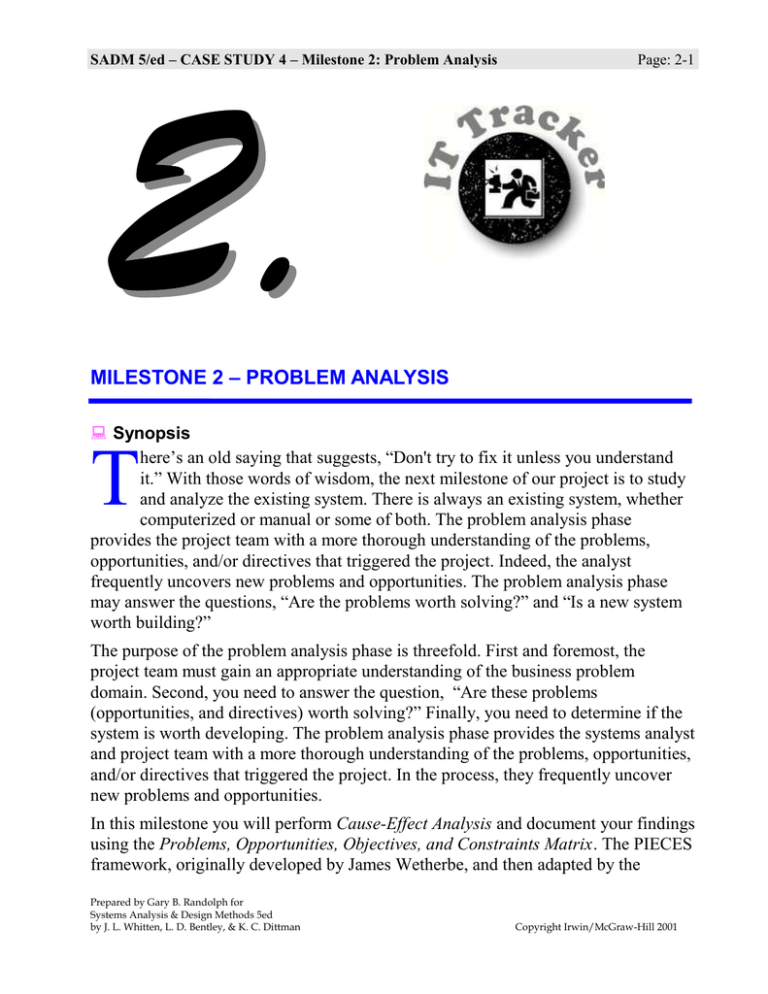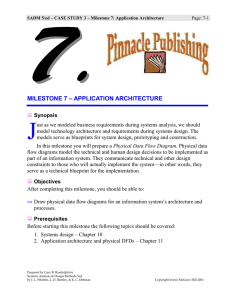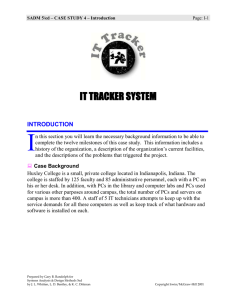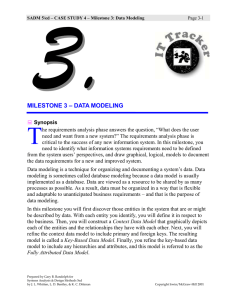T – PROBLEM ANALYSIS MILESTONE 2
advertisement

SADM 5/ed – CASE STUDY 4 – Milestone 2: Problem Analysis Page: 2-1 MILESTONE 2 – PROBLEM ANALYSIS Synopsis here’s an old saying that suggests, “Don't try to fix it unless you understand it.” With those words of wisdom, the next milestone of our project is to study and analyze the existing system. There is always an existing system, whether computerized or manual or some of both. The problem analysis phase provides the project team with a more thorough understanding of the problems, opportunities, and/or directives that triggered the project. Indeed, the analyst frequently uncovers new problems and opportunities. The problem analysis phase may answer the questions, “Are the problems worth solving?” and “Is a new system worth building?” T The purpose of the problem analysis phase is threefold. First and foremost, the project team must gain an appropriate understanding of the business problem domain. Second, you need to answer the question, “Are these problems (opportunities, and directives) worth solving?” Finally, you need to determine if the system is worth developing. The problem analysis phase provides the systems analyst and project team with a more thorough understanding of the problems, opportunities, and/or directives that triggered the project. In the process, they frequently uncover new problems and opportunities. In this milestone you will perform Cause-Effect Analysis and document your findings using the Problems, Opportunities, Objectives, and Constraints Matrix. The PIECES framework, originally developed by James Wetherbe, and then adapted by the Prepared by Gary B. Randolph for Systems Analysis & Design Methods 5ed by J. L. Whitten, L. D. Bentley, & K. C. Dittman Copyright Irwin/McGraw-Hill 2001 SADM 5/ed – CASE STUDY 4 – Milestone 2: Problem Analysis Page: 2-2 authors, can serve as a useful tool to classify the various problems, opportunities, and directives identified in Milestone 1. Objectives After completing this milestone, you should be able to: Perform Cause-Effect Analysis to be able to thoroughly understand a system’s problems, opportunities, and/or directives that triggered the project. Use and understand the PIECES framework for classifying problems, opportunities, and directives. Complete the Problems, Opportunities, Objectives, and Constraints Matrix. Prerequisites Before starting this milestone the following topics should be covered: 1. 2. 3. 4. The problem analysis phase – Chapters 3 and 5 Problem analysis techniques – Chapter 6 PIECES Framework – Chapters 3 and 5 Milestone 1 Solution Assignment Now that you have completed the survey of the system, and gained approval to proceed, you can now attempt to gain a better understanding of the current system. In this assignment you will use your results of Milestone 1, plus the case background information and the user interview, to perform cause-effect analysis. The results of this activity will provide you a better understanding of the problems, opportunities, and constraints of the current system. Activities 1. To complete the Problems, Opportunities, Objectives, and Constraints Matrix, use the interview presented in this milestone. Use the PIECES framework as a model to classify the problems, opportunities, and directives. Deliverable format and software to be used are according to your instructor’s specifications. Deliverables should be neatly packaged in a binder, separated with a tab divider labeled “Milestone 2,” and optionally accompanied with a Milestone Evaluation Sheet. Prepared by Gary B. Randolph for Systems Analysis & Design Methods 5ed by J. L. Whitten, L. D. Bentley, & K. C. Dittman Copyright Irwin/McGraw-Hill 2001 SADM 5/ed – CASE STUDY 4 – Milestone 2: Problem Analysis Page: 2-3 References: Case Background Case Study Introduction Milestone 1 Solution Provided by your instructor Transcripts of IT Tracker meeting Exhibit 2.1 Templates See online learning center web site for the textbook. Prepared by Gary B. Randolph for Systems Analysis & Design Methods 5ed by J. L. Whitten, L. D. Bentley, & K. C. Dittman Copyright Irwin/McGraw-Hill 2001 SADM 5/ed – CASE STUDY 4 – Milestone 2: Problem Analysis Page: 2-4 Deliverables: Problems, Opportunities, Objectives, and Constraints Matrix: Due: __/__/__ Time:_______ ADVANCED OPTIONS Write a detailed study report for the phase. This deliverable was not discussed in the narrative because students need to be exposed to modeling (data, process, & interface) before this report can be completed. For those ambitious individuals who are familiar with those skills and wish to be challenged, use the detailed study report outline found in Chapter 5 of the textbook, as a guideline. Another advanced option is to develop one or more fishbone diagrams for problems outlined in the case. To complete this advanced option, you may need to make some assumptions about causes and effects. Study Report: Due: __/__/__ Time:_______ Fishbone Diagrams Due: __/__/__ Time:_______ Milestone’s Point Value: Prepared by Gary B. Randolph for Systems Analysis & Design Methods 5ed by J. L. Whitten, L. D. Bentley, & K. C. Dittman ____ Copyright Irwin/McGraw-Hill 2001 SADM 5/ed – CASE STUDY 4 – Milestone 2: Problem Analysis Page: 2-5 Exhibit 2.1 The following is a transcript of a meeting of Frank Baravelli (systems analyst for the IT Tracker project), Julius Marx (IT Director), Sy Burnett of the Tech Support staff, Sarah Bellum of the Admissions Office (to represent end-users of the proposed system), and Max Stout of the Accounting Department (to represent the concerns of Vice President of Finance Calvert). Scene: The Information Technology meeting room at Huxley College. Frank has just finished introductions and is explaining the purpose of the meeting. Frank: Each of you has received a copy of the Request for System Services and the Problem Statement Matrix we have developed in investigating the IT Tracker system. As I continue that investigation, each of you has been suggested as possible panel members to help me (1) more fully understand the current system and the need for the new system and (2) document any constraints for designing the new system – things that it either must do or must not do. Mr. Marx sees the IT Management side. Mr. Burnett sees the tech staff side. Ms. Bellum sees the end-user side. Mr. Stout sees the accounting side. I’d like to start with problems in the current system. What is preventing it from working? Prepared by Gary B. Randolph for Systems Analysis & Design Methods 5ed by J. L. Whitten, L. D. Bentley, & K. C. Dittman Sy: I think the biggest problems are lack of automation, lack of integration, and lack of accessibility. We have just one piece computerized now – the PC Configurations. But that isn’t integrated with purchase order information, so it is a big pain to look up warranty information. The warranty information is on paper. The service requests are on paper. There’s no flow of data from one part to the next. Frank: What about the accessibility? Sy: Because it is on paper, I can’t get at anything. I don’t know what other techs have done or any machine history. Sometimes I go out to do something to a computer only to find that someone else tried that last week and it didn’t work. Sarah: I would like better accessibility, too. We users feel like we’re in the dark out there. We call in a service request. It may be days before anyone comes, and we don’t know what’s going on. Copyright Irwin/McGraw-Hill 2001 SADM 5/ed – CASE STUDY 4 – Milestone 2: Problem Analysis Sy: Well, we do the best we can, Sarah. We are understaffed and hampered by the lack of a good tracking system. Frank: I don’t think Sarah was trying to point fingers. Our goal for this meeting is to look at the underlying causes and effects and to set objectives and constraints. Sarah, what could we change in the system to improve your satisfaction? Sarah: Mainly I would like to know the status of my request – who is coming out and when will they get here. Frank: Our initial thinking was to provide just that. If we give you look-up capability, would it also be reasonable to have you enter your own service requests instead of phoning them in? Sarah: That would actually be better for me. I’ve had cases where things were lost in the translation, and the tech came out expecting to find a different problem than what actually existed. Sy: I’m not saying that couldn’t or shouldn’t be done. But I have a few concerns, namely security and ease-of-use. I want this system to solve our problems, not create more through bad or missing data that some user messed up or a student hacked. Prepared by Gary B. Randolph for Systems Analysis & Design Methods 5ed by J. L. Whitten, L. D. Bentley, & K. C. Dittman Page: 2-6 Julius: I think I can answer that one. Though it is too early to talk about implementation specifics, let’s assume for the sake of argument that we use a web user interface and SQL Server on the back-end. We can use SQL Server security both to keep out hackers and to prevent anyone from doing any more than we want them to. And how many users couldn’t fill out a web form to submit or query information? Sy: That sounds reasonable. A web front-end would also make sure it could run on any computer we have – Windows, Linux, Mac, whatever. Julius: But let’s not commit ourselves to a particular solution yet. For now we just have to note that the proposed system has to have an easy-to-use interface. Sy: And that handles updates without us going out to every PC and installing a new version. Julius: Right. And that the solution must be platform-independent and secure. Max: You talk about integrating everything. But we can’t have purchase orders pulled out of the mainframe accounting program. And we sure don’t want anyone else in our system. Copyright Irwin/McGraw-Hill 2001 SADM 5/ed – CASE STUDY 4 – Milestone 2: Problem Analysis Sy: But we need that information in the system. You don’t know how many hours we spend combing through printed POs looking to verify warranty information. Max: I would think that if you just record the PO number used to purchase each item when you install that item, you could go right to it. Sy: Max, we need more than just the PO number. We need the PO date and the vendor. Max: All of which is available if you record the PO with your data and then look up the paper. Sy: We are drowning in paper as it is. We need to automate this. Max: I’m just saying that Dr. Calvert won’t go for anything that impinges the integrity of our accounting system. Julius: I think there are some steps we can take to make everyone happy. We do need to integrate that purchase information for parts inventory as well as the other reasons. But we are sensitive to your needs, Max. We only need purchase order data in read-only format. If we could just have that, it would allow us to automate what we need and maintain the security you want. Prepared by Gary B. Randolph for Systems Analysis & Design Methods 5ed by J. L. Whitten, L. D. Bentley, & K. C. Dittman Page: 2-7 Max: But if your staff is even reading our data, won’t that slow down performance for us? Julius: We could make sure it doesn’t. We could grab a copy of the data at night, and all our work would be with the copy. Max: Okay. But Dr. Calvert also wants to make sure that you don’t start growing some alternative accounting system out here. Can you promise me that this system will never include accounting reports? Julius: I can promise you that your office will be involved in all future plans and requests to enhance the system. As for this present phase, the closest things to accounting that we want to do are an inventory of uninstalled components and some total cost of ownership (TCO) calculations. Max: As an accountant, I can tell you that you can’t calculate a true total cost of ownership without extensive accounting data. Julius: I know that. We just want to look at the direct costs of components with standard service and downtime estimates. That would be so much more helpful than what we have now. That’s all I need for my management. Copyright Irwin/McGraw-Hill 2001 SADM 5/ed – CASE STUDY 4 – Milestone 2: Problem Analysis Max: Page: 2-8 I think total cost of ownership will still worry Dr. Calvert. Julius: Would it make him feel better if we stipulated that TCO is a side benefit of the system and that no data will be included in the system solely to calculate TCO? Max: Yes, it would. Julius: Then make that a system constraint, Frank. Frank: Yes, sir. Is there anything else I need to know? Julius: Let me be more specific on total cost of ownership. I want to look at TCO by computer and by department. One other thing, have you ever heard of a digital dashboard, Frank? Frank: It is a way to track key management statistics, isn’t it? Julius: Yes. There are many service statistics I would like to track. That would lead to continuous improvement in our service and better management. I would like the system to include a digital dashboard for me. Frank: Got it. Well that gives me plenty to work on. I’d like to thank each of you for your time. I will be sending you a copy of my Problems, Opportunities, Objectives, and Constraints Matrix. Let me know if you have any comments or questions. Prepared by Gary B. Randolph for Systems Analysis & Design Methods 5ed by J. L. Whitten, L. D. Bentley, & K. C. Dittman Copyright Irwin/McGraw-Hill 2001





